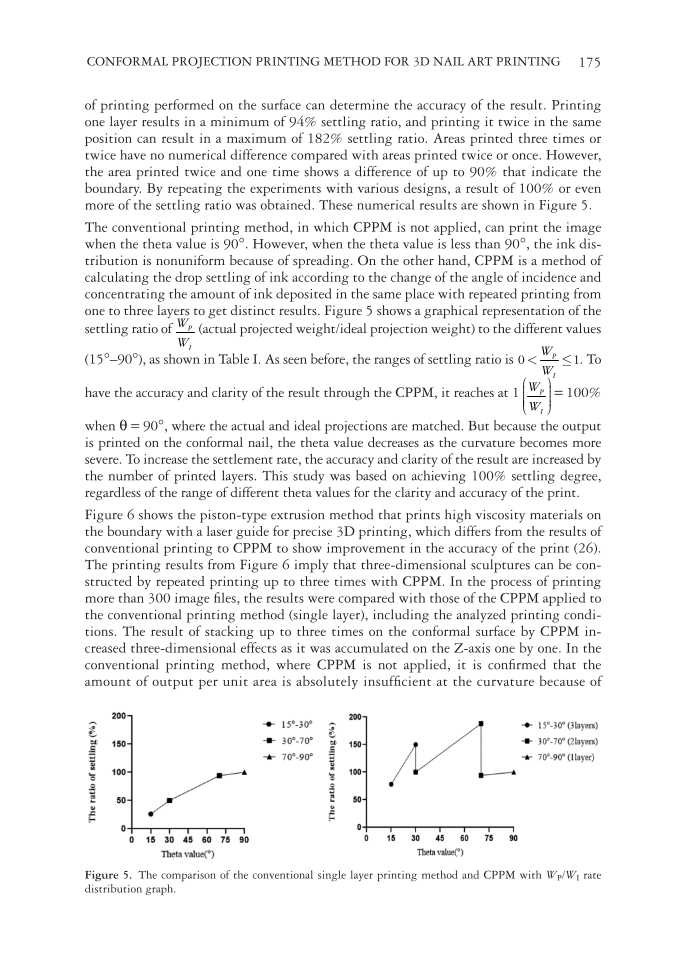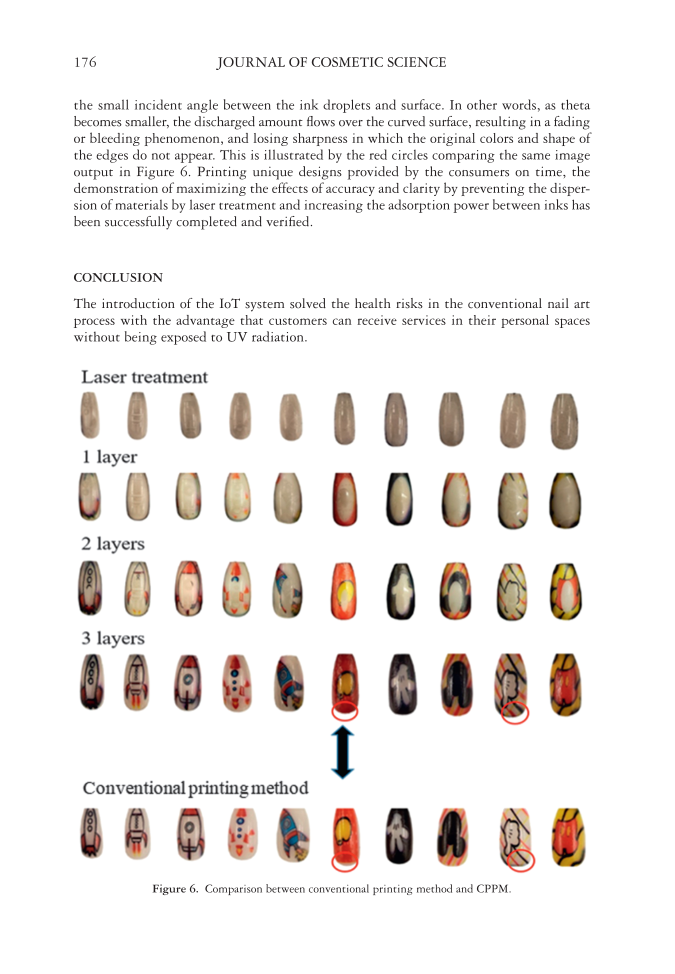CONFORMAL PROJECTION PRINTING METHOD FOR 3D NAIL ART PRINTING 175 of printing performed on the surface can determine the accuracy of the result. Printing one layer results in a minimum of 94% settling ratio, and printing it twice in the same position can result in a maximum of 182% settling ratio. Areas printed three times or twice have no numerical difference compared with areas printed twice or once. However, the area printed twice and one time shows a difference of up to 90% that indicate the boundary. By repeating the experiments with various designs, a result of 100% or even more of the settling ratio was obtained. These numerical results are shown in Figure 5. The conventional printing method, in which CPPM is not applied, can print the image when the theta value is 90°. However, when the theta value is less than 90°, the ink dis- tribution is nonuniform because of spreading. On the other hand, CPPM is a method of calculating the drop settling of ink according to the change of the angle of incidence and concentrating the amount of ink deposited in the same place with repeated printing from one to three layers to get distinct results. Figure 5 shows a graphical representation of the settling ratio of I WP W (actual projected weight/ideal projection weight) to the different values (15°–90°), as shown in Table I. As seen before, the ranges of settling ratio is b1. 0 WP WI To have the accuracy and clarity of the result through the CPPM, it reaches at 1 ¬ WP ® I W = 100% when θ = 90°, where the actual and ideal projections are matched. But because the output is printed on the conformal nail, the theta value decreases as the curvature becomes more severe. To increase the settlement rate, the accuracy and clarity of the result are increased by the number of printed layers. This study was based on achieving 100% settling degree, regardless of the range of different theta values for the clarity and accuracy of the print. Figure 6 shows the piston-type extrusion method that prints high viscosity materials on the boundary with a laser guide for precise 3D printing, which differs from the results of conventional printing to CPPM to show improvement in the accuracy of the print (26). The printing results from Figure 6 imply that three-dimensional sculptures can be con- structed by repeated printing up to three times with CPPM. In the process of printing more than 300 image fi les, the results were compared with those of the CPPM applied to the conventional printing method (single layer), including the analyzed printing condi- tions. The result of stacking up to three times on the conformal surface by CPPM in- creased three-dimensional effects as it was accumulated on the Z-axis one by one. In the conventional printing method, where CPPM is not applied, it is confi rmed that the amount of output per unit area is absolutely insuffi cient at the curvature because of Figure 5. The comparison of the conventional single layer printing method and CPPM with WP/WI rate distribution graph.
JOURNAL OF COSMETIC SCIENCE 176 the small incident angle between the ink droplets and surface. In other words, as theta becomes smaller, the discharged amount fl ows over the curved surface, resulting in a fading or bleeding phenomenon, and losing sharpness in which the original colors and shape of the edges do not appear. This is illustrated by the red circles comparing the same image output in Figure 6. Printing unique designs provided by the consumers on time, the demonstration of maximizing the effects of accuracy and clarity by preventing the disper- sion of materials by laser treatment and increasing the adsorption power between inks has been successfully completed and verifi ed. CONCLUSI O N The intr oduction of the IoT system solved the health risks in the conventional nail art process with the advantage that customers can receive services in their personal spaces without being exposed to UV radiation. Figure 6. Comparison between conventional printing method and CPPM.
Purchased for the exclusive use of nofirst nolast (unknown) From: SCC Media Library & Resource Center (library.scconline.org)











































































